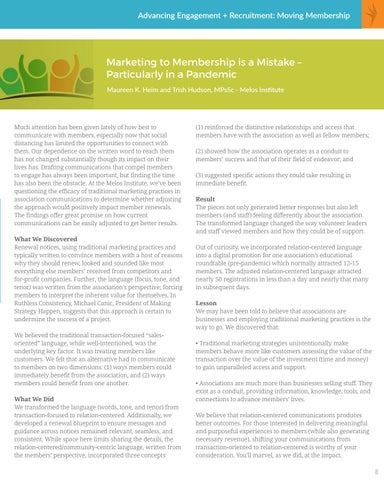Advancing Engagement + Recruitment: Moving Membership
Marketing to Membership is a Mistake – Particularly in a Pandemic Maureen K. Heim and Trish Hudson, MPsSc - Melos Institute
Much attention has been given lately of how best to communicate with members, especially now that social distancing has limited the opportunities to connect with them. Our dependence on the written word to reach them has not changed substantially though its impact on their lives has. Drafting communications that compel members to engage has always been important, but finding the time has also been the obstacle. At the Melos Institute, we’ve been questioning the efficacy of traditional marketing practices in association communications to determine whether adjusting the approach would positively impact member renewals. The findings offer great promise on how current communications can be easily adjusted to get better results. What We Discovered Renewal notices, using traditional marketing practices and typically written to convince members with a host of reasons why they should renew, looked and sounded like most everything else members’ received from competitors and for-profit companies. Further, the language (focus, tone, and tenor) was written from the association’s perspective; forcing members to interpret the inherent value for themselves. In Ruthless Consistency, Michael Canic, President of Making Strategy Happen, suggests that this approach is certain to undermine the success of a project. We believed the traditional transaction-focused “salesoriented” language, while well-intentioned, was the underlying key factor. It was treating members like customers. We felt that an alternative had to communicate to members on two dimensions: (1) ways members could immediately benefit from the association, and (2) ways members could benefit from one another. What We Did We transformed the language (words, tone, and tenor) from transaction-focused to relation-centered. Additionally, we developed a renewal blueprint to ensure messages and guidance across notices remained relevant, seamless, and consistent. While space here limits sharing the details, the relation-centered/community-centric language, written from the members’ perspective, incorporated three concepts:
(1) reinforced the distinctive relationships and access that members have with the association as well as fellow members; (2) showed how the association operates as a conduit to members’ success and that of their field of endeavor; and (3) suggested specific actions they could take resulting in immediate benefit. Result The pieces not only generated better responses but also left members (and staff) feeling differently about the association. The transformed language changed the way volunteer leaders and staff viewed members and how they could be of support. Out of curiosity, we incorporated relation-centered language into a digital promotion for one association’s educational roundtable (pre-pandemic) which normally attracted 12-15 members. The adjusted relation-centered language attracted nearly 50 registrations in less than a day and nearly that many in subsequent days. Lesson We may have been told to believe that associations are businesses and employing traditional marketing practices is the way to go. We discovered that: • Traditional marketing strategies unintentionally make members behave more like customers assessing the value of the transaction over the value of the investment (time and money) to gain unparalleled access and support. • Associations are much more than businesses selling stuff. They exist as a conduit, providing information, knowledge, tools, and connections to advance members’ lives. We believe that relation-centered communications produces better outcomes. For those interested in delivering meaningful and purposeful experiences to members (while also generating necessary revenue), shifting your communications from transaction-oriented to relation-centered is worthy of your consideration. You’ll marvel, as we did, at the impact.
8





